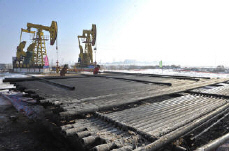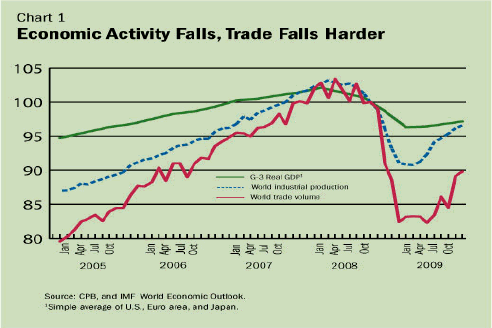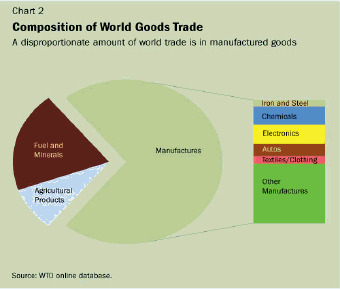
Typical street scene in Santa Ana, El Salvador. (Photo: iStock)
IMF Survey: Open Markets Would Support Rebound in Trade in 2010
January 13, 2010
- Trade rebound dependent on broad economic recovery
- IMF call to resist protectionism
- Conclusion of Doha trade talks could support durable trade growth
World trade looks set to continue its tentative recovery in 2010, but the sustainability of any upturn will depend on policymakers’ actions.

Steel pipes on Chinese oil field. Steel pipes — one source of trade friction in 2009. IMF warns of the dangers of protectionism. (EPA/Mark/Corbis)
Trade Recovery
Since May, global commerce has reversed its dramatic plunge, shadowing the hesitant global recovery—but it has a long way to go before it returns to pre-crisis levels (see Chart 1).
“While trade appears to be rebounding on the coat tails of the economic upturn for now, policymakers need to resist protectionist pressures to guarantee a durable trade revival,“ said Christian Henn of the IMF.
“In addition, if nations could come to an agreement and conclude the Doha trade talks, then the resulting reduction in trade barriers and increased security for traders and investors could provide a positive impulse for trade for years to come,” added Henn, an economist with the IMF’s Strategy, Policy, and Review Department.

Impact of stimulus measures on trade
Underlining the need to boost trade by concluding Doha, some analysts suggest the present rebound in trade may be the result of temporary stimulus measures. In the U.S. for example, fiscal stimulus amounted to over $780 billion and the Federal Reserve has reduced short-term interest rates close to zero. Globally, these and similar measures have boosted demand. One example is the “cash for clunkers” scheme—a $3 billion federally-funded measure that allowed consumers to trade in their old vehicles in return for subsidized purchases of new, more fuel-efficient cars. Other countries, including in Europe, have implemented similar programs.
“The danger is that car imports may return to depressed levels because what might have happened is that demand has simply been brought forward,“ said Henn, with owners replacing vehicles in 2009, that they might otherwise have replaced in 2010.
Unprecedented drop in trade values
Global trade collapsed in late 2008 and that contraction continued into the first quarter of 2009. Although trade tends to decline more than overall economic activity during downturns, the scale of the drop during this most recent recession was unprecedented. Trade volume declined by 18 percent and there was a 30 percent drop in trade values.
The nature of global trade means economic downturns are now magnified in the trade sector. Goods are traded many times along global supply chains, crossing many national borders before reaching the end consumer. So, products and their components add to trade volumes and values several times, but add to global GDP just once.
The recent trade slump was also compounded by the composition of modern-day traded goods. A disproportionate amount of world trade is in consumer durables (see Chart 2) and capital products whose purchase can be postponed. In contrast, these “postponeables” represent only a small fraction of world GDP, which is largely made up of services and nondurable products.
The knock-on effect of falling trade
At the beginning of the crisis, consumers cut back on purchases of durables, while firms shelved or delayed investment plans, lowering demand for capital goods. Bank-mediated trade financing was also affected with higher interest rates across the board. Small and medium-sized enterprises in developing countries found it difficult to access credit. Given the easing of access to credit and budding consumer confidence, this pattern should improve in the coming year.
The factors which accelerated the downturn in trade—including the dominance of manufactured goods in global merchandise trade and the effect of the global supply chain on trade volumes—could now have the reverse effect of aiding recovery in trade in 2010.
Many export-oriented countries, for example, those in Asia that experienced among the sharpest falls in trade and growth during the slump, could now continue to experience strong rebounds.

The dangers of protectionism
Given the depth of global integration, trade experts warn that likely protectionist sentiment needs to be resisted in the coming year. Although a recent WTO report (www.wto.org) confirms no widespread resort to protectionism, the Global Trade Alert (www.globaltradealert.org) identifies several hundred—though mostly narrowly-targeted—protectionist measures that have been introduced since the beginning of the crisis. These range from tariff barriers, to increased subsidies, and more stringent rules for imports.
“Up till now, the impact of protectionism has been contained only because measures have affected a limited amount of trade. But with unemployment still high, substantial pent-up demand for protectionism remains with many protectionist measures already passed, but not yet implemented,” said Henn.
He added that concluding the Doha trade round would send a positive signal by providing greater security for trade relations, as well as benefiting developing countries through the introduction of trade facilitation programs.







